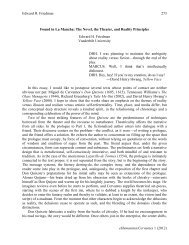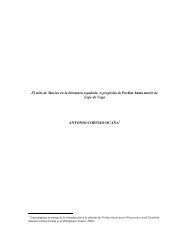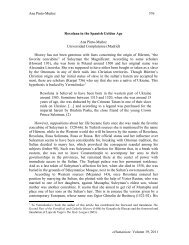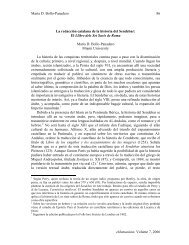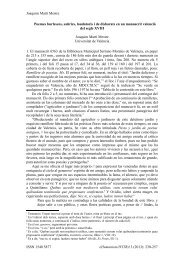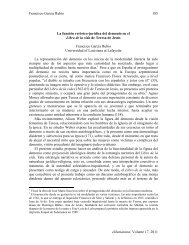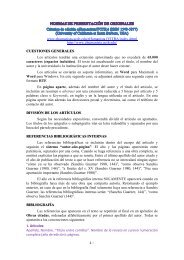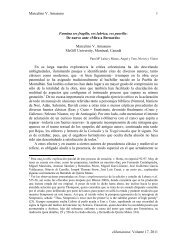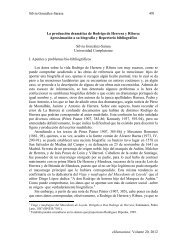Gregory Peter Andrachuk eHumanista: Volume 17, 2011 540 Alonso ...
Gregory Peter Andrachuk eHumanista: Volume 17, 2011 540 Alonso ...
Gregory Peter Andrachuk eHumanista: Volume 17, 2011 540 Alonso ...
Create successful ePaper yourself
Turn your PDF publications into a flip-book with our unique Google optimized e-Paper software.
<strong>Gregory</strong> <strong>Peter</strong> <strong>Andrachuk</strong><br />
as a member of the courtly elite, on intimate and relaxed terms with those at the<br />
highest level of society –truly, a person “que se halló en todo” (1).<br />
The most extraordinary connection in the text between the Viceroy Ramón de<br />
Cardona, and Vasquirán is one which, as far as I am aware, has not received the<br />
attention it merits. At the gala evening celebration following the joust Vasquirán<br />
appears wearing the very clothes that the Viceroy wore earlier that same day: “Sacó<br />
Vasquirán la ropa de carmesí qu’el visrey auía sacado aquel día...porque era conocida<br />
que no era suya” (154). This is a most unusual occurrence in a society which ascribes<br />
meaning to every aspect of behaviour and appearance; the readers of Qüestión de<br />
amor would most certainly search for a meaning in this act. For Vasquirán to choose<br />
deliberately to wear the clothing of another instead of new clothing, and for the<br />
Viceroy to lend his own clothing to another in circumstances in which appearance was<br />
everything, can only be seen to be highly symbolic. 6 The colours of clothing referred<br />
normally to the colours of the family of the wearer, or of the family of the lady served<br />
by the wearer, or they symbolized some aspect of the mood of the wearer. Vasquirán,<br />
however, serves no lady other than his beloved but deceased Violina. The colours he<br />
wears now are not the colours of a lady he serves for he has made clear by the letra<br />
even now that he is in mourning –yet he does not wear black 7 and that fact alone<br />
would attract the interest of observers and readers.<br />
I believe that the clues embedded earlier in the text have all been a prelude to this<br />
single and most obvious clue: Vasquirán is wearing the clothing of the Viceroy (the<br />
principal colour of which was carmesí) precisely because the author intends him to be<br />
identified intimately with the Viceroy; the Viceroy’s colours are his colours and the<br />
6 Masters often gave their used clothing to servants as a reward for service; this was an expected<br />
practice of largesse. In fact, Vasquirán made just such a gift to the servant Felisel: “Diole vn jubón de<br />
brocado que con aquel atauío Vasquirán se auía vestido” (32). But if the same act were to take place<br />
between those of similar rank it would almost certainly be interpreted as condescension. There is no<br />
suggestion whatever of such an attitude in Vasquirán’s wearing of the Viceroy’s clothing; therefore we<br />
must seek a different interpretation. Clothing, and the commissioning of new clothing, is a major<br />
element in this book and Vasquirán, no less than the other characters, has shown an interest in fashion,<br />
and more importantly, an acute awareness of the symbolic importance of clothing and of colours, a fact<br />
exemplified in his apparel and the decoration of his house after the death of Violina. See Felisel’s report<br />
of Vasquirán’s house and his personal appearance (18-23).<br />
7 “Siendo ell alegría agena/al que no tiene placer, / más triste le haze ser” (154). He does, however,<br />
maintain the signs of mourning at the tela in the black colour of his clothing and that of his attendants<br />
(148). The Cardona arms always include three golden thistles (“cardos”) on a red (“carmesí”)<br />
background. Despite the identification of the authorial voice with the character Vasquirán, we must not<br />
automatically accept the novelistic portrayal of events in Vasquirán’s life as accurately representing<br />
those in the life of the author. In other words, it is not to be assumed that the author was in mourning,<br />
that he was unmarried, or that he ever entered into a debate of this nature with his friend Jerónimo de<br />
Fenollet (Flamiano); these are all constructs necessary to the sentimental romance. The reality of the<br />
author’s life may have been very different.<br />
543<br />
<strong>eHumanista</strong>: <strong>Volume</strong> <strong>17</strong>, <strong>2011</strong>



